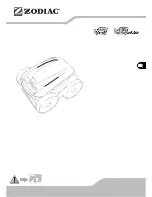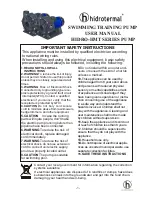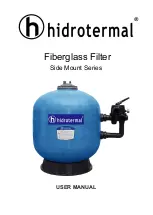
J.) Troubleshooting
(Continued)
ООО "Бассейн-Сервис" – продажа и монтаж оборудования для бассейнов.
Тел: 8 (800) 700-65-50,
5.) Improper test kit readings.
Make sure you follow the proper Ion-Test kit procedures. Many people look at the side
of the test tubes instead of looking down from the top. Also, be sure to wait three minutes for the reagents to develop.
These reagents should be replaced yearly and kept out of direct sunlight and stored at normal room temperature. Failure
to do so will cause faulty readings. Never let the reagents freeze or be exposed to extreme heat.
6.) Improper pH readings
This is usually the main reason for a low copper-ion level. Make sure the pH is maintained
between 7.2- 7.8 , with the power end preferred. When the pH goes over 7.8, the ions fall out of solution. Make sure
your test kit is updated with fresh reagents and kept out of direct sunlight and in normal room temperatures. Never mix
different manufacturer’s reagents with the test kit.
7.) Too much chlorine in the pool
If the pool was just shocked with a lot of chlorine, this can give you an improper test
kit reading on the Ion Test Kit. The high chlorine level will “bleach” out the reading and appear to read zero.
8.) Sequestering Agents or Metal Out Removers in the water
Sometimes pool owners will add a flocking or
sequestering agent to the water to remove stains or scaling in a pool or remove undesired minerals that are in the source
water. Some of these will interfere with the
MineralPURE’s
ions such as Sequasol, Cop-Out, Metal Magnet, Aluminum
Sulfate or Alum. Products that won’t cause problems and that are actually recommended to use with
Mineral Pure
include Pool Stain Treat by
United Chemical
or
Jack’s Magic
. All polymer based products like Super Blue and Sea-Klear
do not cause problems either. If you are unsure if a sequestering agent is causing a low ion level, send Clearwater Enviro
Technologies a water sample to test. If it is a problem (these agents can stay in the water for up to a year) add a lot of
chlorine to shock it out of the pool water.
9.) Steel plumbing
Never install the electrodes on steel piping. Cut out a section of this and replace with PVC pipe.
10.) Improper installation
Sometimes installers will mount the electrodes on a bypass line and not on the actual return
line that goes back to the pool’s water. Make sure unit is on properly with correct connections.
11.) High Phosphate level
A high phosphate level will be a feeding ground for algae. If you have a lot of algae
growing and can’t keep the Ion level up, you may have a high phosphate level. Any reading over 125 ppb can cause
problems. Have your pool store test for phosphates or contact your dealer or
Clearwater
for more information. There are
products available that will remove phosphates from the water quickly and will eliminate algae and low Ion readings.
12.) TDS too low
The RC-50 should work at any reading with a TDS of about 400ppm or so. All TDS levels go up
when anything is added to the pool water, but if you need to, add regular salt to the pool to bring up the TDS level. One
pound of salt will add 12ppm of TDS per 10,000 gallons.
If you have had the pool for several months or years and the “check electrode” scroll comes on and you are unable to keep
the unit on a higher setting, the electrodes may need to be cleaned or replaced. See chapter
“H”
in this manual.
When initially installing the unit and you notice the “inspect electrode” scroll coming on, or when you try to set the unit
to a higher reading and it returns back to a lower setting, this is due to a low TDS or Total Dissolved Solids reading.
Chances are your pool has brand new water in it.
Do not be alarmed.
For example, the RC-50 can reach 600 on the
control box, but it goes back to 525 or something like that. Unless your pool is 50,000 gallons or your water is very warm
(90 degrees) and you are unable to reach the desired Ion level in the pool, there is nothing to worry about. If you are
unable to obtain the desired Ion level and all other factors listed in this chapter have been ruled out, you should test the
TDS level. Any pool store can give you this reading or your dealer might have a meter with him.
Can’t Obtain the Proper Copper-Ion Level
(Continued)
“Inspect electrode & make sure TDS is not too low” scroll comes on / unable to keep desired readout on display




































